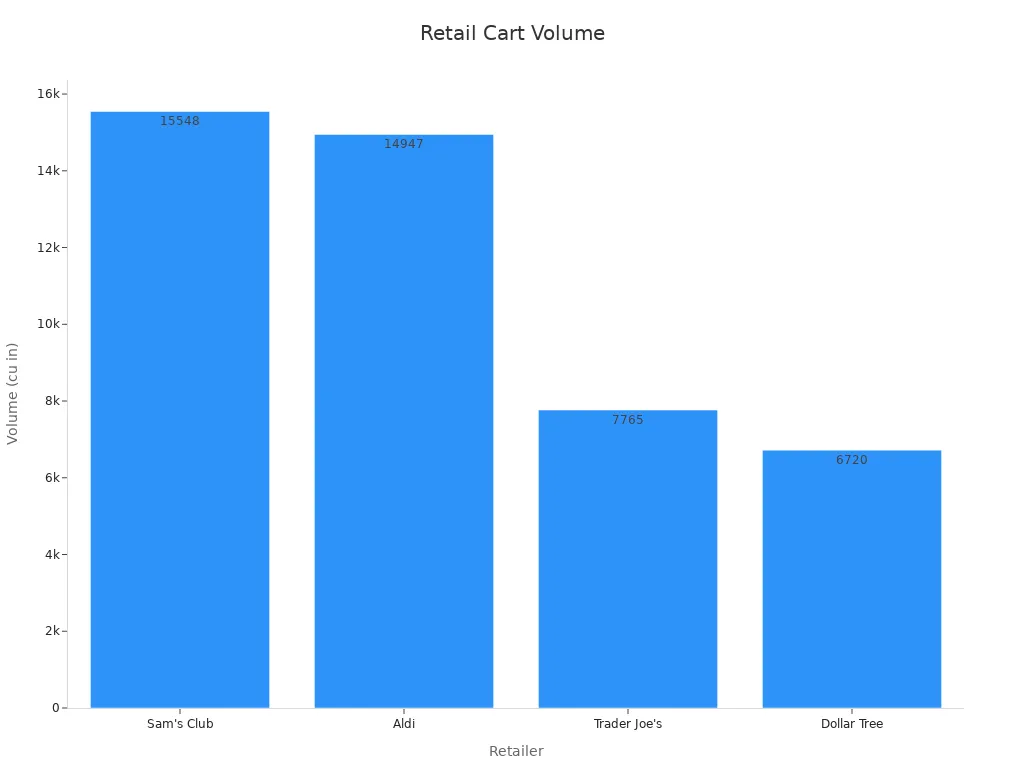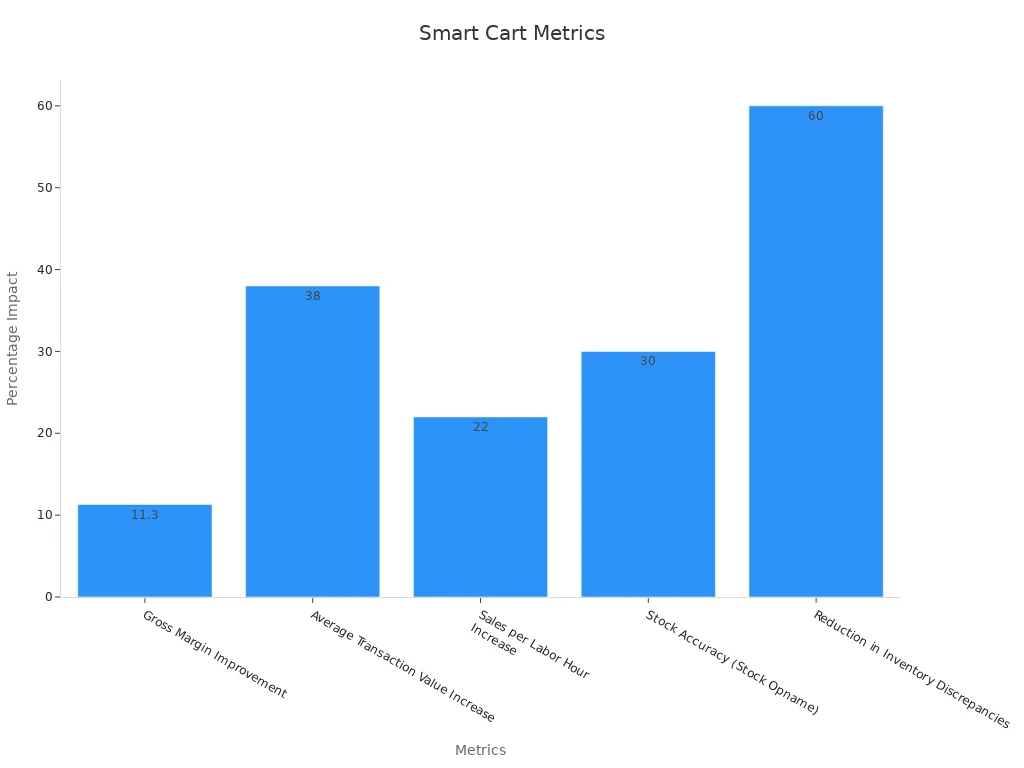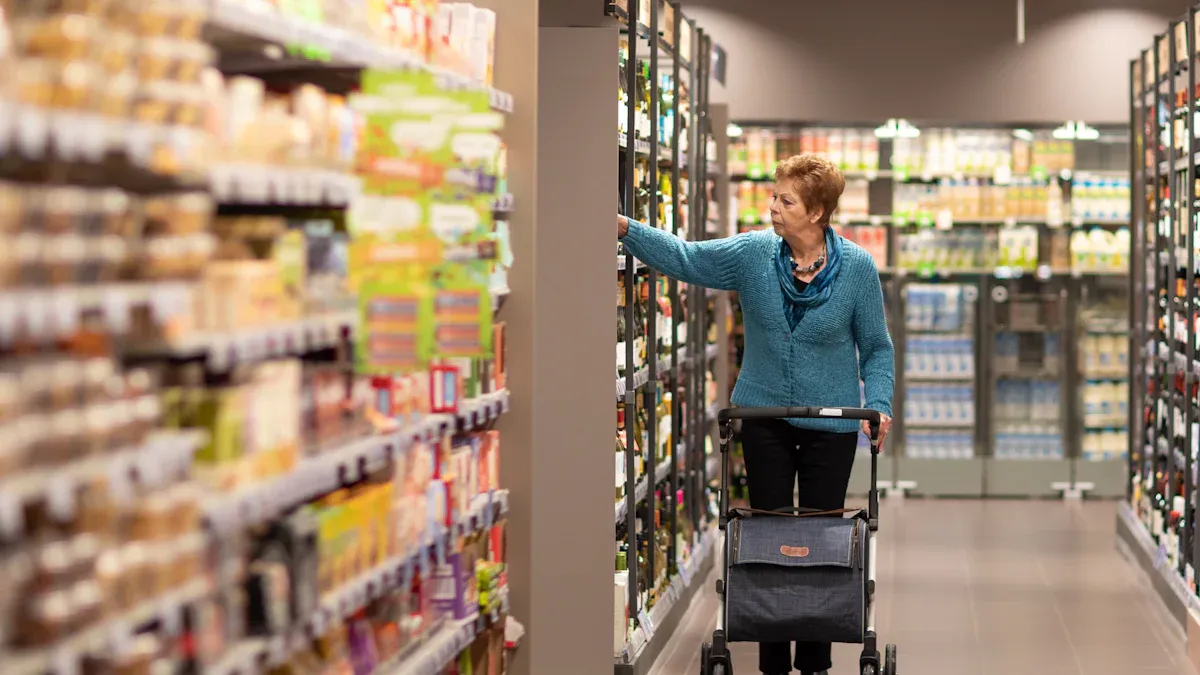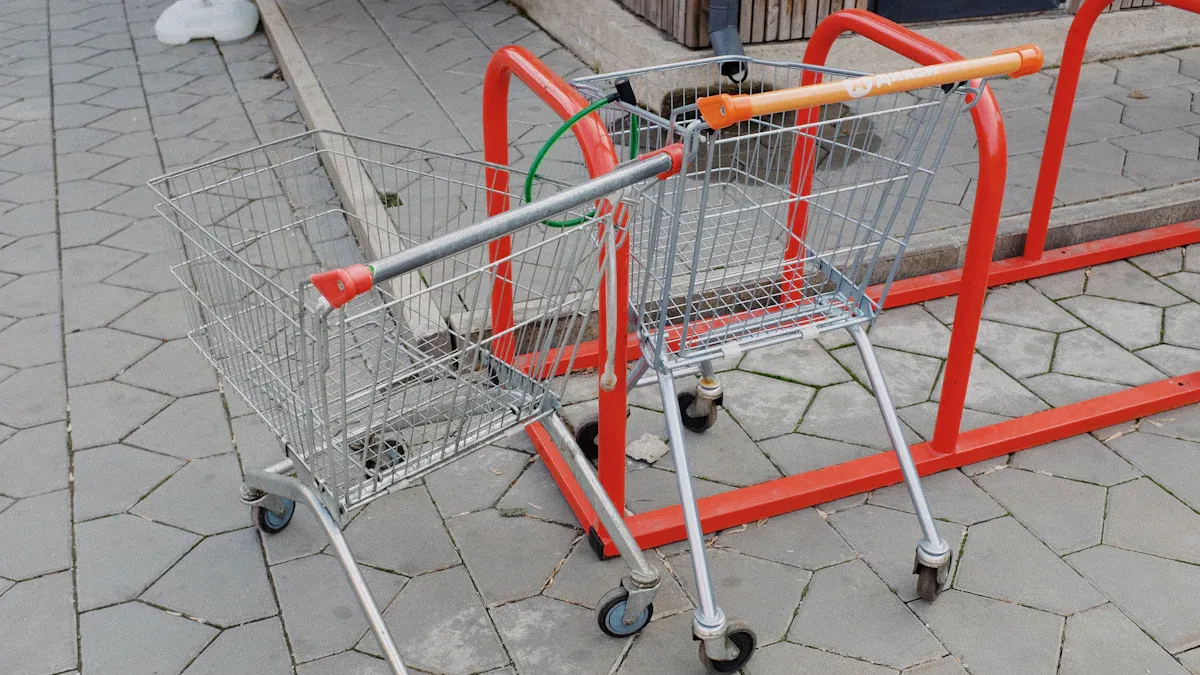Trolley Cart Shopping: Comparing Traditional vs. Electric Options for Retail Environments

If you want the best results from trolley cart shopping in a retail store, focus on your store’s needs. Traditional retail store carts work well for high-volume stores like Sam’s Club or Aldi, where larger cart volume (over 15,000 cubic inches) encourages bulk purchases.

Smart electric carts offer more features and convenience, such as remote controls and less physical effort, but cost more to buy and maintain. Think about what matters most to you—features, cost, convenience, or accessibility—when choosing your trolley cart shopping solution.
Key Takeaways
Traditional shopping carts are simple, reliable, and cost-effective, making them ideal for stores with bulk shoppers and low maintenance needs.
Smart shopping carts use technology to speed up checkout, track prices in real time, and offer personalized product suggestions, improving the shopping experience.
Electric carts reduce physical effort with motorized wheels and adjustable features, helping shoppers with limited strength or mobility.
Smart carts require higher upfront and maintenance costs but can increase sales, customer satisfaction, and store efficiency through data collection and automation.
Choosing the right cart depends on your store’s size, shopper needs, budget, and goals; consider starting with a pilot program to test smart carts before full adoption.
Trolley Cart Shopping Overview
Trolley cart shopping shapes how you move through a store and what you buy. When you enter a retail environment, your choice of cart can change your entire shopping journey. Stores use trolley cart shopping to help you carry more items, shop comfortably, and even act on special promotions. Your age and needs often guide your choice. Younger shoppers may skip carts, while older shoppers prefer baskets or carts for support and convenience.
Trolley cart shopping does more than hold your groceries. It can influence your spending, help you find deals, and make shopping easier if you have limited mobility. However, it can also lead to overspending or food waste if you fill your cart too quickly.
Here is a table that shows how trolley cart shopping affects different shoppers and their experiences:
Aspect | Evidence Summary |
|---|---|
Age-related preferences | Younger consumers (<40) prefer no equipment; consumers 41+ prefer baskets; oldest consumers increasingly prefer carts. |
Positive consequences | Carts provide large carrying capacity, convenience (space for personal items), aid for restricted mobility, and enable acting on promotions. |
Negative consequences | Risk of overspending, food waste, reduced shopping efficiency, physical difficulty handling carts, hygiene concerns, and injury risks especially for children falling from carts. |
Behavioral impact | Choice of carrying equipment at store entrance influences entire in-store journey and purchasing behavior, including healthy vs. unhealthy product choices. |
Evolution | Shift in consumer preferences with age; integration of carts as a consumer touch point affecting shopping behavior and safety considerations. |
Traditional Shopping Cart
A traditional shopping cart gives you a simple way to carry groceries and other items. You push it by hand, and it has a metal or plastic frame with wheels. This type of cart works well for large stores where you might buy in bulk. It offers a big basket and a child seat. Many shoppers like the traditional shopping cart because it is easy to use and does not require any technology. However, you may find it hard to push when it is full or if you have limited strength.
Smart Shopping Cart
A smart shopping cart uses technology to make your trip easier and faster. Shopping smart carts often have touchscreens, barcode scanners, and sensors. These features help you track your spending, find products, and even check out without waiting in line. Shopping smart carts can also give you special offers based on what you put in your cart. Stores that use shopping smart carts see higher sales and happier customers.

Shopping smart carts improve store operations, too. They help staff keep track of stock and reduce mistakes. Many shoppers enjoy shopping smart carts because they save time and make shopping more fun. However, some people worry about privacy and data collection. Surveys show that most customers want stores to be clear about how they use data from shopping smart carts.
Customer satisfaction scores go up with shopping smart carts.
Checkout time drops, so you spend less time waiting.
Sales conversion rates rise because of helpful recommendations.
The average basket size grows as shopping smart carts encourage you to add more items.
Trolley cart shopping continues to evolve. Whether you choose a traditional shopping cart or a smart shopping cart, your experience depends on your needs and the store’s technology.
Key Differences

Design and Technology
You see big changes in design and technology when you compare traditional shopping carts and shopping smart carts. Traditional shopping carts use simple frames made from metal or plastic. They have four wheels and a basket. You push them by hand. These carts work well for most stores, but they do not offer much in terms of new features.
Shopping smart carts bring new technology into your shopping experience. Many smart carts use touchscreens, barcode scanners, and sensors. Some even have AI-powered navigation systems that help you move through the store. These systems can suggest the best route and help you find products faster. You can check out right at the cart, which saves time.
Modern shopping smart carts use advanced parts to improve how they work. Here are some of the latest design features you might find:
Threaded stem casters make carts easier to steer and last longer. You spend less time dealing with broken wheels.
Mini caster wheels help carts move in tight spaces. This is great for small stores or crowded aisles.
Adjustable height casters let you use the cart on different types of floors. You do not have to worry about bumps or uneven surfaces.
Robotic assembly lines build carts with more precision. This makes carts stronger and helps stores get new carts faster.
3D-printed parts allow stores to order custom carts. This cuts down on production time and costs.
Some carts use recycled plastics and solar panels. These features help stores lower their environmental impact.
Shopping smart carts also use predictive maintenance systems. These systems tell staff when a cart needs repair. This lowers costs and keeps carts working longer. Automated Guided Vehicles (AGVs) can even move carts around the store or warehouse without human help. These changes make shopping smart carts a big step forward in design and technology.
Accessibility and Inclusivity
You want every shopper to feel welcome and comfortable. Traditional shopping carts offer a simple design that most people can use. They have a large basket and a child seat. Many shoppers like the familiar feel of these carts. However, some people find traditional shopping carts hard to push, especially if they have limited strength or mobility.
Shopping smart carts improve accessibility for many shoppers. Some smart carts have adjustable handles. You can set the height to match your needs. This makes the cart easier to use for people of different ages and abilities. Shopping smart carts often include features like voice guidance or large touchscreens. These features help people with vision or hearing challenges.
Stores that use shopping smart carts can also offer carts with powered wheels. You do not have to push as hard, which helps older adults or people with disabilities. Some smart carts even have built-in seats or support bars. These features give you extra comfort during your shopping experience.
Shopping smart carts help staff as well. Predictive maintenance systems alert workers when a cart needs attention. This means fewer broken carts and a better shopping experience for everyone. By using new technology, stores can make shopping more inclusive and enjoyable for all.
Features Comparison
Convenience
You want your shopping trip to be as easy as possible. Traditional shopping carts give you a simple experience. You grab a cart, push it around, and fill it with your items. These carts use lightweight materials and ergonomic designs to help you move through the store. You may find them stable and easy to maneuver, but they still require physical effort. If you shop for a long time or fill your cart with heavy items, you might feel tired.
Electric trolley carts change the way you shop. These carts use motorized wheels and rechargeable batteries. You can adjust the handle height and choose different speed settings. Some models even have GPS and smart technology. You get help moving the cart, which makes shopping easier for older adults or anyone with limited strength. Many shoppers enjoy features like built-in screens, barcode scanners, and automatic checkout. These features support contactless shopping, so you spend less time waiting in line and more time finding what you need.
Here is a table that compares the convenience factors of both cart types:
Convenience Factor | Traditional Manual Push/Pull Carts | Electric Trolley Carts |
|---|---|---|
Physical Effort | Manual pushing/pulling, can cause strain | Motorized, reduces strain, easier for all ages |
Features | Simple, stable, lightweight, ergonomic | Adjustable handles, speed settings, GPS, smart tech |
Market Growth | Stable, but facing competition | Growing fast, driven by tech and convenience |
User Preferences | Favored by traditionalists | Preferred by tech-savvy and older shoppers |
Innovation | Hybrid models emerging | Advanced batteries, AI, automation |
You see more stores offering electric carts because shoppers want comfort and speed. Contactless shopping becomes easier with smart carts, letting you check out right at the cart. You save time and avoid crowded checkout lines.
Environmental Impact
You care about the environment when you shop. Traditional shopping carts do not use electricity or batteries. They create no emissions during use. You only need to push them, so they do not add to your carbon footprint. Many stores now use recycled plastics and metals to build these carts, which helps reduce waste.
Electric trolley carts also support a cleaner environment. They use rechargeable batteries, so you do not need gas or disposable batteries. These carts run quietly and use less energy. Some models even include solar panels to recharge while you shop. Both cart types help stores lower their environmental impact, but electric carts offer new ways to save energy and reduce noise.
You might notice that electric carts need batteries and electronics, which require careful recycling. Stores must plan for battery disposal and electronic waste. Still, the overall impact stays low if stores follow good recycling practices.
Maintenance
You want your cart to work every time you shop. Maintenance plays a big role in keeping carts safe and reliable. Traditional shopping carts have a simple design. They use wheels, a frame, and a basket. You see fewer parts that can break, so maintenance costs stay low. Stores often choose these carts because they last a long time and need only basic repairs.
Electric trolley carts use more advanced parts. They have motors, batteries, sensors, and screens. These features make shopping easier, but they also need more care. Stores must check batteries, update software, and fix electronics. Predictive maintenance systems help by warning staff before a cart breaks down. This keeps carts working and reduces downtime.
Here is a table that shows the main differences in maintenance:
Maintenance Type | Description | Cost Factors and Impact |
|---|---|---|
Preventive Maintenance | Regular checks and repairs | Low cost, keeps carts working longer |
Predictive Maintenance | Uses sensors to spot problems early | Higher upfront cost, saves money over time |
Breakdown Maintenance | Fixes after something breaks | Can be expensive, causes downtime |
Repairs | Fixing broken parts | Cost depends on part and urgency |
Regular maintenance extends the life of both cart types.
Well-maintained carts keep shoppers safe and protect the store’s reputation.
Preventive programs save money and reduce the risk of accidents.
Stores can choose how often to check carts, such as monthly or quarterly.
You see that electric carts need more attention, but they offer better performance and features. Traditional carts cost less to maintain, but they do not provide the same level of convenience or technology.
Cost Analysis
Upfront Costs
You need to think about the money you spend at the start. Traditional shopping carts cost less to buy. Most stores pay between $75 and $150 for each cart. You can order them in bulk and save more. These carts use simple materials like metal or plastic.
Electric or smart carts cost much more. You might pay $1,500 to $5,000 for each smart cart. These carts have motors, batteries, screens, and sensors. You also pay for software and setup. Some stores need to upgrade their Wi-Fi or power outlets to use smart carts.
Here is a table to help you compare:
Cart Type | Average Upfront Cost per Cart | Extra Setup Needed? |
|---|---|---|
Traditional Cart | $75 – $150 | No |
Electric/Smart | $1,500 – $5,000 | Yes (tech, power, Wi-Fi) |
Tip: If you run a small store, you might start with traditional carts. If you want to impress tech-savvy shoppers, smart carts could be worth the investment.
Ongoing Expenses
You also need to plan for costs that come later. Traditional carts need cleaning, wheel repairs, and sometimes new baskets. These repairs do not cost much. You can fix most problems quickly.
Electric or smart carts need more care. You must charge batteries, update software, and replace parts like screens or sensors. Repairs cost more because you need special tools or trained staff. You may also pay for tech support or software subscriptions.
Here are some ongoing expenses to consider:
Traditional Carts:
Cleaning and sanitizing
Wheel and frame repairs
Occasional replacement
Electric/Smart Carts:
Battery charging and replacement
Software updates
Tech support fees
Higher repair costs
Note: Smart carts can save you money over time by reducing checkout staff needs, but only if you use them well.
Shopping Experience

Customer Perspective
Your shopping experience starts the moment you grab a cart. Traditional carts give you a familiar feel. You push them through the aisles, fill them with items, and head to the checkout process. These carts work well for most shoppers, but you may feel tired if you shop for a long time or carry heavy items. Families often choose child carts because they keep kids safe and entertained, making the shopping experience more enjoyable and less stressful.
Smart carts change your shopping experience in new ways. You get features like touchscreens, barcode scanners, and even weight sensors. These tools help you track spending and find products faster. Some smart carts let you finish the checkout process right at the cart, so you skip long lines. This makes your shopping experience faster and more satisfying.
Here is a table showing how different cart types affect your shopping experience:
Cart Type | Customer Satisfaction & Shopping Experience Impact |
|---|---|
Roller Basket | Easy to move, reduces crowding, gives you more control and comfort. |
Cargo Carts | Handles heavy loads, lowers strain, lets you shop longer. |
Child Carts | Keeps kids safe and happy, improves family shopping experience, encourages longer visits. |
Tote/Smart Carts | Smart tech speeds up checkout, personalizes shopping, reduces cart abandonment, boosts satisfaction. |
Basket Carts | Great for quick trips, easy to store, keeps the store tidy. |
Specialty Carts | Meets special needs, makes shopping easier for everyone. |
A well-designed cart makes your shopping experience safer and more fun. You spend more time in the store, buy more, and feel in control. Smart carts use AI to suggest products and help you finish shopping faster, making the whole journey smoother.
Retailer Perspective
As a retailer, you want every shopping experience to be positive. The right cart type can boost foot traffic and increase sales. Traditional carts keep things simple and reliable. They help you manage large crowds and encourage bigger purchases. Smart carts, on the other hand, give you real-time data about what shoppers buy and how they move through the store. This helps you improve store layout and marketing.
Smart carts also make the checkout process faster, which means you need fewer cashiers. You can track key performance indicators like conversion rate and average transaction value. These numbers show how well your store performs and how the shopping experience changes with different carts.
Customer service improves when you use carts that fit your shoppers’ needs. Features like self-service checkout and easy-to-move carts help customers solve problems on their own. This raises customer satisfaction scores and builds loyalty. When you track metrics like first contact resolution and self-service rates, you see how much the right cart can improve the shopping experience for everyone.
Pros and Cons
Traditional Shopping Cart
You find traditional shopping carts in almost every store. These carts give you a simple and familiar way to shop. You do not need to learn anything new. You just grab a cart and start shopping. Most people like how easy it is to use a traditional shopping cart. You never worry about batteries or screens. You can trust that the cart will work every time.
However, traditional shopping carts have some limits. You must push them yourself, which can get tiring if you fill the cart with heavy items. You cannot weigh produce or track your spending as you shop. If you want to know the price of your groceries, you need to keep a mental tally, which can lead to mistakes. You also have to unload everything at the checkout and wait in line. These steps can slow you down, especially during busy hours.
Tip: Traditional shopping carts work best if you want a no-fuss shopping trip and do not mind waiting at checkout.
Smart Shopping Cart
A smart shopping cart brings new technology to your shopping experience. You can scan items as you shop, and the cart shows you the total price right away. This helps you stay on budget and avoid surprises at checkout. Some smart carts have built-in scales, so you can weigh fruits and vegetables without leaving the aisle. You also get product suggestions and special offers based on what you put in your cart.
You pay for your groceries right on the cart’s screen, so you skip the checkout line. Stores use smart carts to collect data about what you buy, which helps them improve service and manage inventory. Still, you may need to learn how to use the new features. Some shoppers feel unsure about using technology for the first time.
Here is a quick table to help you compare:
Feature | Traditional Shopping Carts | Smart Shopping Cart |
|---|---|---|
Ease of Use | Very easy, no learning needed | Some learning required |
Weighing Items | Not available | Built-in scales |
Price Tracking | Manual, can be hard | Automatic, real-time |
Checkout | Wait in line, unload items | Pay directly on cart |
Product Suggestions | None | Personalized offers |
Data Collection | None | Yes, for store analytics |
Note: Smart carts make shopping faster and more personal, but you may need to get used to the new system.
Choosing the Right Cart
Use Cases
You need to match the right cart to your store’s needs. Different environments and shoppers benefit from different trolley cart options. For example, in a hospital or healthcare setting, a redesigned pediatric code cart helped staff find lifesaving items faster. Staff made fewer mistakes and felt more confident using the new cart. The improved organization also made restocking easier and reduced costs. These changes show how a well-designed cart can make a big difference in high-pressure situations.
In retail stores, you might choose traditional carts for large supermarkets where shoppers buy in bulk. Smart carts work well in tech-focused stores or places with many older adults who need extra help. Specialty carts, like child carts or roller baskets, fit stores that serve families or want to save space.
In hospitals, organized carts save time and reduce errors.
In supermarkets, traditional carts handle heavy loads and bulk shopping.
In tech-forward stores, smart carts speed up checkout and help with product tracking.
In family-focused stores, child carts and roller baskets improve safety and comfort.
Tip: Think about your shoppers’ needs and your store’s layout before choosing a cart type.
Decision Factors
You should look at several key factors before making your choice. The table below shows important decision metrics and how they compare:
Decision Factor Metric | Details and Comparative Insights |
|---|---|
Innovation | Automated trolley systems reduce physical labor; RFID enables tracking and analytics |
Product Types | Roller baskets, child carts, tote boxes, basket carts, cargo carts; basket carts offer better maneuverability and safety |
Materials | Stainless steel, plastic hybrid, aluminum, others |
Wheel Configurations | Three-wheel and four-wheel options |
Quality Standards | Compliance with EN 1929 Standard ensures high quality |
Regional Market Insights | North America leads in adoption and analytics; Europe focuses on quality; Asia Pacific grows fastest |
Market Growth | Market expected to grow from $1.3B (2023) to $11.49B (2032), with a 27.4% growth rate |
Smart Features Impact | Mobile OS integration and automation improve convenience and management |
Manufacturer Influence | Regional manufacturers affect availability and innovation |
You should consider innovation, product type, materials, and smart features. Regional trends and manufacturer presence also play a role. By weighing these factors, you can choose the best cart for your store and your customers.
Quick Reference Table
Choosing the right trolley cart can feel overwhelming. You want a quick way to see the main differences. Use this table to compare traditional and smart/electric carts side by side. This guide helps you make the best choice for your store or shopping trip.
Feature | Traditional Shopping Cart | Smart/Electric Shopping Cart |
|---|---|---|
Ease of Use | Simple, no learning needed | Some learning, touchscreen controls |
Physical Effort | Manual pushing, can be tiring | Motorized, less effort needed |
Wait in line, unload items | Pay at cart, skip lines | |
Price Tracking | Manual, keep mental tally | Automatic, real-time display |
Accessibility | Standard handles, basic design | Adjustable handles, voice guidance |
Maintenance | Low, basic repairs | Higher, needs tech support |
Upfront Cost | $75–$150 per cart | $1,500–$5,000 per cart |
Ongoing Expenses | Low, simple repairs | Higher, battery and software upkeep |
Environmental Impact | No batteries, recyclable parts | Rechargeable, needs battery disposal |
Data Collection | None | Yes, for store analytics |
Special Features | Child seat, large basket | Barcode scanner, product suggestions |
Tip:
If you want a simple and reliable cart, choose a traditional one. If you want more features and faster checkout, try a smart cart.
You can use this table to match your needs with the right cart.
Think about your shoppers, store size, and budget before you decide.
Remember, the best cart is the one that fits your goals.
You now know the key differences between traditional and smart shopping carts. Traditional carts work best for stores that want reliability and low costs. Smart carts fit stores that value speed, data, and customer experience.
Tip: List your store’s needs and compare them to each cart’s features.
If you plan to upgrade, start with a pilot program. Share your thoughts or questions in the comments below! 🛒
FAQ
What are the main benefits of using a smart shopping cart?
You get faster checkout, real-time price tracking, and product suggestions. Smart carts help you save time and make shopping easier. Stores use them to improve your experience and gather helpful data.
Tip: Try a smart cart if you want a high-tech, quick shopping trip.
Are electric shopping carts safe for all ages?
Yes, you can use electric carts safely. Stores design them with safety features like speed controls and stable wheels. Staff often help you learn how to use them. Always follow the instructions for the best experience.
How do I maintain a traditional shopping cart?
You should check the wheels, clean the basket, and tighten any loose parts. Regular cleaning keeps the cart safe and ready for use. Stores often schedule monthly or quarterly maintenance.
Do smart carts collect my personal data?
Smart carts may collect data about your shopping habits. Stores use this information to improve service and offer deals. You can ask staff about privacy policies if you have concerns.
Data Collected | How Stores Use It |
|---|---|
Items scanned | Personalized offers |
Shopping routes | Store layout planning |
Can I use both cart types in the same store?
Many stores offer both options. You can choose a traditional cart for a simple trip or a smart cart for more features. Pick the cart that fits your needs and comfort level.
See Also
Transforming Retail Access Through Innovative Grocery Vending Solutions
Smart Technology Driving Change In Electronics Vending Retail
Modern Retail Advantages Of AI-Driven Combo Vending Machines
Space-Efficient Tabletop Snack Vending Machines For Contemporary Areas
Revolutionizing Online Store Management With AI E-Commerce Tools
